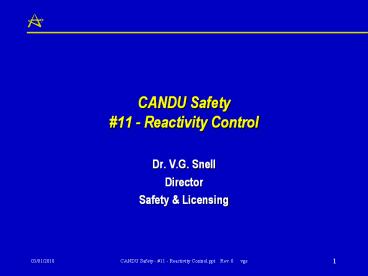CANDU Safety
1 / 21
Title: CANDU Safety
1
CANDU Safety11 - Reactivity Control
- Dr. V.G. Snell
- Director
- Safety Licensing
2
Basis for Reactivity Control
- CANDU
- small reactivity feedback continuous automatic
control - dual redundant digital computers
- small rates of reactivity increase
- just enough reactivity range for short term
control - refuelling is the long-term control
- LWRs
- large negative feedback set and forget
- manual or semi-automatic control
- large reactivity depth to compensate for fuel
burnup
3
Basic Reactivity Control Logic - Short Term
4
Digital Computer Control
- 2 identical computers
- master (controlling), slave (active standby)
- control, alarms and display
- all major functions duplicated (except for
fuelling) - hardware and software self-checking, external
timer - input / output rationality checking
- fault in one computer transfers control to the
other - fault in both computers causes station shutdown
- experience availability of gt99 for each computer
5
Reactivity Devices
6
Reactivity Control Devices - Top of Reactor View
7
Zone Controllers
- primary means of normal control
- bulk power control and spatial flux control
- they work by varying level in H2O filled
compartments - 14 controllers in 6 vertical tubes
- fill on reactor trip
8
Adjuster Rods
- 21 rods, in 7 banks
- normally fully inserted for flux shaping
- used for partial xenon override to recover from
trip - used in case of unavailability of fuelling
machine - freeze on reactor trip
9
Absorber Rods
- 4 rods, normally out of core
- like shutoff rods but no spring
- drive in / out or drop by releasing clutch
- used to supplement zone controllers
- fast power reduction for abnormal events (3
seconds) - stepback - prevent reactor from going critical on shutoff
rod withdrawal - dropped on reactor trip
10
On-Power Fuelling
- long term reactivity control
- long term power shape control
- typically 2 channels / day
- fuel management code advises on channels to be
refuelled - refuelling operation mostly automatic
completely remote
11
Hardware Safety Interlocks
- if reactor is tripped
- prevent adjuster / absorber removal
- prevent moderator poison removal
- cannot withdraw shutoff rods if shutdown system 2
is unavailable (not re-poised) - cannot withdraw excess number of adjusters
simultaneously
12
Setback
- reduces power at controlled rate if normal limits
exceeded - initiated by control computers
- end points vary from 60 to 0.02 full power
- examples
13
Stepback
- fast reduction of power, may avoid reactor trip
- initiated by control computers
- releases clutches on control absorbers, full or
partial drop - examples
14
Accident Analysis - Loss of Reactivity Control
- definition reactor regulating system
malfunctions so as to cause increase in local or
bulk power - defences
- setback (not credited)
- stepback (not credited)
- Shutdown System 1 - independent of control
computers - Shutdown System 2 - independent of control
computers - early experience gt 1 loss of reactivity control
per year on average all stopped by shutdown
system - improved with addition of setback / stepback
- current design target 1 per 100 years
15
Acceptance Criteria
- Class 1 dose limits set by AECB
- two effective trips on each shutdown system where
practical - prevent fuel sheath failures
- no dryout or limited time in dryout
- not the same as burnout in a LWR
- prevent heat transport system boundary failure
- pressure lt110 design for SDS1, lt120 for SDS2
- no pressure tube failure due to overheating
16
Cases Analyzed
- increase in bulk power
- power continues to rise, or
- power stops rising just below neutron trip
setpoint - increase in local power
- slow increases from distorted flux shapes
- hundreds of cases
- basis of Regional Overpower Protection System
design - various initial power levels from full power to
shutdown - primary circuit pressurized or depressurized at
zero power
17
Typical Cases Analyzed
Reactivity
Overpower trip setpoint
122
Power
Power
Time
Time
Reactivity Ramp
Bounded Power Rise
18
Relevant Trips
- high neutron power trip (122)
- high rate log neutron power trip
- 10 / sec for SDS1, 15 / sec for SDS2
- high heat transport system pressure trip
- 10.34 MPa, if power gt70, 3-5 second delay
- 10.55 MPa on SDS1, 11.72 MPa on SDS2, immediate
- low coolant flow if power gt0.1 (SDS1)
- low core differential pressure if power gt0.3 - 5
(SDS2)
19
Reactivity Ramp
- linear reactivity ramps
- varied from very slow to the fastest the control
devices can achieve - system simulations to predict
- reactor physics
- fuel temperature
- heat transport system thermohydraulics
- pressure tube temperature
- key calculation critical versus actual heat flux
for hottest fuel element
20
Trip Coverage Map
- purpose to show for each shutdown system there
are at least 2 trips for an accident starting
from various operating states - whole power range
- various initial conditions
- in some cases only one trip is practical e.g.,
fast reactivity ramps from very low power
21
Summary
- low reactivity rates and small ranges because of
on-power refuelling - reliable redundant digital computer control
- large core means that spatial overpower
protection is required for control safety - setback, stepback and two shutdown systems
provide defences against loss of reactivity
control































